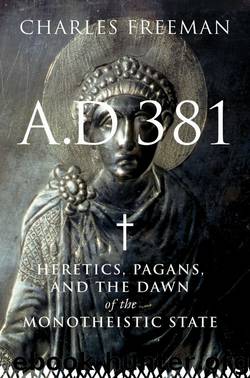A. D. 381 by Charles Freeman

Author:Charles Freeman
Language: eng
Format: epub
Publisher: The Overlook Press
Published: 2010-09-30T04:00:00+00:00
IX
THE ASSAULT ON PAGANISM
WHEN Justina and Valentinian fled to Thessalonika, they brought Valentinian’s young sister Galla with them. The pagan writer Zosimus later recorded that no sooner had Theodosius cast his lustful eye on the young girl than he determined to marry her. The truth is probably more prosaic: Theodosius had recently been widowed, and the dynastic advantages of linking himself by marriage to his co-emperor’s family were obvious. It seems clear that Theodosius was developing acute political skills. His compromise treaty with the Goths and his readiness to consider a religious settlement based on a consensus of theological views - the ‘council of the sects’ in 383 - suggest flexibility. He seems to have known when compassion was justified, and while he had no inhibitions about ordering the execution of Maximus and that of his small son, Victor, who had remained in Gaul, he protected the rest of Maximus’ family. Even though he was faced with the evidence that many leading men in Italy and Gaul had abandoned Valentinian in favour of Maximus, he did not launch a witchhunt against them. One can begin to see a man who was learning how to carry out the complex and often impossible task of ruling an empire under threat without intensifying discontent.
Now, in the autumn of 388, Theodosius was in Milan. He was to remain there for three years, leaving the eastern empire in the hands of his son Arcadius and a trusted set of praetorian prefects and proconsuls. Theodosius knew that so long as he did not directly challenge Valentinian’s status, he was unlikely to be dislodged, and his long-term plans might well have been to emerge as emperor in the west. He would, however, have to make a relationship with Ambrose. The two men first met when Theodosius arrived for a service in the cathedral and, following eastern practice, expected to join the clergy for communion. Ambrose, who was insistent on keeping the Church distinct from the court, was forced to rebuff him. It was a deeply embarrassing moment and showed just how poorly defined the relationship between Church and state remained. And it was not long before Ambrose took the opportunity to point out to the emperor his ‘Christian’ duty.
In 388 Theodosius had been irritated by a request for advice from a local governor concerning the sacking of a Jewish synagogue at Callinicum on the Euphrates by a Christian mob led by their bishop. The emperor simply suggested that the bishop should be ordered to bear the cost of restoring the building. When Ambrose heard of the matter, he tried to present the emperor with a very different response to the incident. Reparation, he argued, would involve asking the bishop to betray his faith, and if the bishop refused there would be more trouble, which would bring the risk of a Christian emperor creating new martyrs. Ambrose further dramatised the affair by claiming that he would be happy to take responsibility for giving ‘the orders that there would be no building in which Christ was denied’.
Download
This site does not store any files on its server. We only index and link to content provided by other sites. Please contact the content providers to delete copyright contents if any and email us, we'll remove relevant links or contents immediately.
International Integration of the Brazilian Economy by Elias C. Grivoyannis(74869)
The Radium Girls by Kate Moore(11621)
Turbulence by E. J. Noyes(7700)
Nudge - Improving Decisions about Health, Wealth, and Happiness by Thaler Sunstein(7242)
The Black Swan by Nassim Nicholas Taleb(6764)
Rich Dad Poor Dad by Robert T. Kiyosaki(6176)
Pioneering Portfolio Management by David F. Swensen(6079)
Man-made Catastrophes and Risk Information Concealment by Dmitry Chernov & Didier Sornette(5648)
Zero to One by Peter Thiel(5489)
Secrecy World by Jake Bernstein(4388)
Millionaire: The Philanderer, Gambler, and Duelist Who Invented Modern Finance by Janet Gleeson(4095)
The Age of Surveillance Capitalism by Shoshana Zuboff(3985)
Skin in the Game by Nassim Nicholas Taleb(3965)
The Money Culture by Michael Lewis(3847)
Bullshit Jobs by David Graeber(3831)
Skin in the Game: Hidden Asymmetries in Daily Life by Nassim Nicholas Taleb(3723)
The Dhandho Investor by Mohnish Pabrai(3560)
The Wisdom of Finance by Mihir Desai(3524)
Blockchain Basics by Daniel Drescher(3329)
